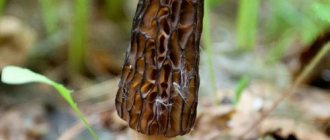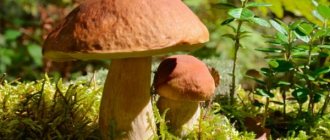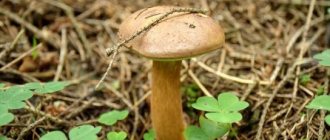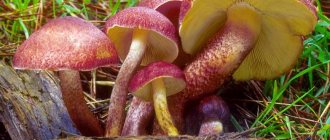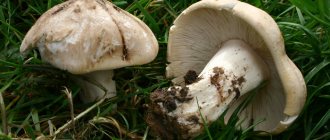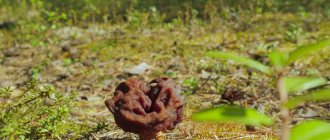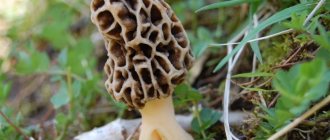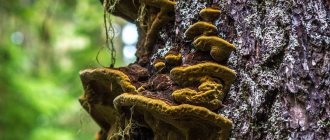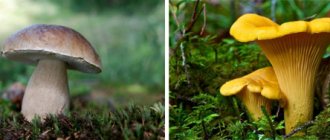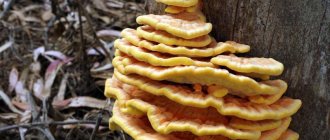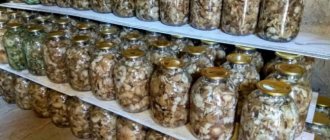Moss fly green. In some areas this mushroom is called the reshetnik or under-lattice mushroom.
Looking ahead, we note that this mushroom can be eaten after all known types of heat treatment. Moss mushroom is especially tasty in dishes with meat, for example, in the recipe for pork with mushrooms in the oven, and in baked goods. To prepare it for the winter, it is best to marinate it.
Mushroom SUBGRESS (Green moss): description
So, the flywheel mushroom grows from June to October-early November throughout almost the entire territory of Russia. Loves coniferous, deciduous and mixed forests. Grows singly and in small groups.
The cap is up to 12 cm in diameter; in a young mushroom it is convex, then cushion-shaped, flatter in the center, thin felt, often cracked.
The color of the cap is olive-brown or yellowish-olive. The tubular layer is bright yellow, later greenish-yellow, with large, uneven, angular pores.
The leg is up to 8 cm long, up to 2 cm thick, cylindrical, solid, yellow, sometimes with a reddish tint. The pulp is weak, whitish or light yellowish.
The subframe can have several shapes depending on the color of the cap and the nature of the surface of the stem. But their quality is the same, and therefore they are of no importance for food use.
As mentioned above, this mushroom is boiled, fried, baked, and young mushrooms are pickled and salted.
The green flywheel has no obvious inedible or poisonous counterparts. But, if you are not experienced, you may confuse it with the inedible pepper mushroom. Its tubular layer has a reddish tint, and its flesh has a sharp, acrid, burning taste.
Watch the video: Inedible mushrooms, photo and name. Poisonous mushrooms
Happy mushroom hunting!
pro-griby.ru
Xerocomus subtomentosus
Other names : reshetnik, podreshetnik, goat mushroom, deaf mushroom, podlutnik
It grows in a variety of forests, often in clearings, road edges, singly or in groups. Sometimes found on anthills. The fungus is cosmopolitan, often found in all regions of Russia, throughout Europe, North America, Australia, on the island of Kalimantan, and extends into the subarctic and subalpine zones. In Russia it bears fruit from May to October.
The cap is up to 12 cm in diameter, fleshy, hemispherical, then cushion-shaped, velvety, olive-brown, with a skin that does not separate from the cap.
The tubular layer is usually adherent, less often slightly running down the stalk, bright yellow and then greenish-yellow in color, with large angular pores.
The leg is up to 8 cm long, up to 2 cm thick, cylindrical, or slightly narrowed downwards, quite dense, solid, without a ring, yellowish, often with a reddish tint at the top.
The pulp is quite loose, light yellow, slightly blue at the break, with a faint fruity odor and pleasant taste.
The spores are elongated-elliptical yellowish, brownish-olive in mass.
The processing methods are the same as for the yellow-brown flywheel. It is most often used freshly prepared, and also dried, salted, and pickled.
It has many variations depending on the color of the cap and the surface of the stem, but in terms of use these differences are not particularly significant.
Somewhat similar to the inedible pepper mushroom, but the latter is distinguished by the acrid bitterness of the pulp and the yellowish-red tubular layer.
Go back to main page
mushroomer.info
It is also a trumpet mushroom, a tubular mushroom, belongs to the genus Suillus bovinus. There are local names: moss grass, moss grass, moss grass, little goat, marsh grass, fireweed, sheep, mullein, dry oiler, mullein. Photos of adult and young goats are shown below in the figures:
The cap is pillow-shaped, convex, sticky. Colors can vary in combinations of yellow, red, ocher, brown. The pulp is elastic, dense, and may turn slightly pink or red when cut. When heat treated it turns purple-pink. The smell of fresh mushroom is not expressive. Reshetnik belongs to the 4th category of nutritional value. Mainly forms mycorrhiza with pine. Widely spread . It can be found in the Far East, Europe, the North Caucasus, Siberia and the Urals.
What can it be confused with? With the pepper mushroom, which has a redder color and smaller size and is used mainly as a seasoning and with late butter, but it does not have a cap ring. The fungus is highly susceptible to worm formation; often the entire colony is infected. It can be considered a record holder for worminess.
How to cook goat? The mushroom is suitable for a variety of ways of consumption: frying, boiling, pickling (preferably). For cooking, young mushrooms are usually taken; the cap must be cut, because it can be infected with worms even if the stalk is normal. After boiling for 15 minutes. the mushroom is ready for further processing.
But the most preferred cooking method is drying . The mushroom should not be washed, because... it doesn't dry well. On hot days it can be dried in the sun by stringing it on a thread. On cloudy days - in the oven, at a temperature not exceeding 70 degrees. Dried and ground goat is an excellent seasoning for seasoning rice, meat dishes and sauces. The aroma intensifies when dried, so a small amount of powder is enough to add piquancy to the dish. Interestingly, some craftsmen even manage to make jam from the grate.
Chemical composition of goat : proteins include amino acids such as tryptophan, methionine, histidine, arginine, etc. Fats include such necessary and important components for the body as lecithin and phosphatides. Carbohydrates are mainly represented by glycogen. In addition, the lattice contains vitamins B3, B2, B1, PP, D, and carotene. Among mineral substances, phosphorus occupies a special place. Photo of the goat is presented. See also: ● Truffle ● Boletus ● Boletus ● On Ch. "Mushrooms"
1000ml.ru
The most exciting activity is mushroom picking. But success in this unique sport depends on the ability to distinguish mushrooms, find places where they grow, and know when and how they grow.
Mushrooms bear fruit from spring to late autumn, but unevenly, but in waves, or, as they also say, in layers, when many fruiting bodies grow in a short period. There are three or four such layers in total.
May is the first month of the mushroom calendar. At this time, snowdrop mushrooms appear - morels and stitches. There is a sign - if a lot of morels are born in the spring, expect a large harvest of other mushrooms in the summer.
Morel and stitch
| Morel | Line |
They are found mainly in pine forests, especially in clearings, in places of fires, fires, and on sandy soil.
These mushrooms are edible, but contain poisonous helvella acid. Therefore, it is best to dry them, and the poison is completely destroyed after a month.
Mushrooms cooked after drying are considered a delicacy and are not inferior in taste and aroma to porcini mushrooms.
At the end of May - beginning of June, the first layer of mushrooms appears. They are often called spikelets, as they are the same age as the rye spike. These are boletuses, boletuses, and even white ones. The second layer of mushrooms - granaries - appear during the harvest, during haymaking and linden flowering (June-July). The third layer - deciduous - occurs after the departure of swifts and cuckoos, when nuts and lingonberries ripen. It is the most productive, the longest, from half of August, all of September, and in warm autumn - until half of October. At this time, chanterelles, moss mushrooms, boletus, saffron milk caps, honey mushrooms, and green mushrooms appear.
Boletus (birch cap, black mushroom)
Found only in birch or mixed with birch forests from May to October. Moisture-loving. The mushroom grows very quickly and quickly becomes soft and flabby. After boletus mushrooms, this is the most delicious of the tubular mushrooms.
Boletus (white mushroom)
Grows in old pine, spruce, birch and oak-broadleaf forests from May to October. The tubular layer at the bottom of the cap is finely porous, at first white, later yellow-green. The leg is white with a white mesh pattern. The pulp is strong, white, does not change color when broken, tastes slightly sweet, with an appetizing smell of lightly toasted nuts.
Mosswort (underframe, goat lips)
It is found in coniferous and deciduous forests near roads, in moss, and on the edges. It usually grows solitarily from June to November. The tubular layer at the bottom of the cap has large, uneven, angular pores, bright yellow in young ones, greenish-yellow in old ones.
Oiler
It grows in groups mainly in young pine trees, on forest edges, near roads, and in new plantings from May to October. The bottom of the cap of a young mushroom is covered with a white “veil”, which will then tear, and the rest of it in the form of a ring will remain on the stem of the mushroom.
Boletus (redhead, boletus)
It is found throughout the forest zone in dry mixed forests, under young trees and in deciduous small forests, abundantly in aspen growths. It grows from June until the end of leaf fall, until frost.
The fox is real
The cap is bright yellow, for which the mushroom received its name, at first convex with rolled edges, then funnel-shaped with strongly wavy edges. It is found abundantly in all forests, especially in damp summers. They grow in large families in the first half of summer and autumn.
In good years, you can pick mushrooms every day in the same place. Therefore, the mushroom picker must take care of the safety of the mycelium. In most cap mushrooms, the mycelium is perennial and lives for 15-25 years. It is very well adapted to various environmental changes and can tolerate severe frosts and drought without harm. In order not to damage the mycelium, it is recommended to cut off the stem of the mushroom with a sharp knife, and not tear it out of the ground, as some would-be mushroom pickers do. It’s even worse when the soil is picked and trampled. Old spore-bearing mushrooms should not be thrown onto the ground, where they will rot uselessly, but rather carefully strung on a branch or branch of a bush so that the spores dry and disperse. Once ripe, the spores fall off and are carried everywhere by wind, water, insects and animals.
We wish you success, mushroom pickers!
Attention! Among our wild mushrooms there are not only edible, but also poisonous. At first glance, some poisonous mushrooms look very similar to edible ones. These doubles should be especially feared. That is why, when going for mushrooms, you must remember the main differences between good edible mushrooms and their poisonous counterparts.
Gall fungus (false white)
This inedible mushroom at a young age is very similar to a porcini mushroom. The main differences from the boletus are: a dark mesh pattern on the stem, a dirty pink bottom of the cap, the flesh turns pink at the break, and the taste is bitter (just lick the bottom of the cap).
Death cap
This is the most poisonous, deadly mushroom. Rarely found in deciduous forests on the edges and clearings.
Pepper mushroom (lamb)
Externally, the mushroom is similar to an oil can, but smaller. A tubular layer with large uneven pores and a yellowish-red tint, bitter pulp.
fly agaric
A very poisonous mushroom. It is found often, in some places very abundantly, in birch and mixed forests.
False chanterelle
Unlike the edible chanterelle, which has curved and corrugated edges of the cap, the false one has a funnel-shaped cap with a smooth edge. The color of a real chanterelle is bright yellow, while the false one is red-orange.
Russula is pungent and pungent
The mushroom cap has red and pink shades, the stem is white and smooth. This russula differs from food russula in that it tastes bitter and burning (if you lick the cut of the stem).
SOURCE : Magazine “Ksyusha. For lovers of handicrafts. Skillful hands"
www.rukodelie.by
Mushroom “reshetnik”, “podreshetnik”, “goat” and so on, these are all common names for the same mushroom - green flywheel.
Moss mushrooms, like all other tubular mushrooms, are cleaned quite traditionally. Fresh mushrooms need to be sorted out, cleaned of large forest debris (leaves, pine needles, etc.), large mushrooms should be cut immediately and checked for the presence of “worms”, then all mushrooms should be rinsed well, preferably under running water.
Collected fresh mushrooms should not be stored for a long time; they very quickly lose their presentation. It is best to peel these mushrooms and immediately boil them in lightly salted water with the addition of a small amount of vinegar or citric acid, otherwise they will turn black.
10nebo.ru
What do baby goat mushrooms look like?
The mushrooms are medium in size, the caps are slimy or slippery, especially after rain. On the reverse side, the cap has pores of yellow, light orange, olive and gray shades. The color of spores in this genus of mushrooms is usually brown.
The cap of the goat is yellow-brown or creamy-beige; in young specimens the cap is soft with a slightly curled white edge. The top of the cap is quite smooth, but may be a little sticky. In humid conditions it is slimy, and in dry conditions it is matte.
With age, the curling disappears, the cap becomes flattened and reaches a diameter of 3-10 cm. The color of the mushroom stem is the same as that of the cap, it is 3-6 cm long and 0.5-1.5 cm thick. The stem does not have a ring. The flesh is pale yellow and becomes pinkish with age.
Young goats are tasty, but older ones become rubbery with age. The leg is hollow, rounded, curved. The mesh on the underside of the cap resembles a small honeycomb. The flesh turns blue at the break. The tubular layer does not separate from the cap.
Growing
Today, growing mushrooms in your own garden beds is very popular among gardeners. In addition to the well-known champignons and oyster mushrooms, people have learned to successfully plant other species, such as porcini mushrooms, honey mushrooms, etc. You can also grow thistle at home. However, it is worth noting that the first time a positive result may not be so impressive, since the yield and quality of mushrooms largely depend on natural conditions, proper planting and care.
But, if you get the hang of it over time, you can harvest a decent harvest without going into the wilds of the forest. To grow sweetgrass on your property, you will need to purchase powdered mycelium. It is usually sold in packages per 1 m².
Did you know? The body of the mushroom is considered to be the mycelium, which extends over a long distance in the ground, and the mushroom itself
-
this is just its fruit.
Before sowing, it is mixed with 0.5 kg of dry soil or sand . To plant, you need to select an area near any tree, dig the ground to a depth of about 10 cm, forming a small depression on the surface. Now you need to scatter the mycelium evenly. The top of the planting should be sprinkled with a layer of ordinary garden soil mixed with humus in equal proportions. The bed is watered at the rate of 10 liters of water per 1 m².
The planting must be watered during dry periods, delivering 15–20 liters of settled water per 1 m². The first mushrooms will appear 2.5 months after planting. The harvest will be relatively poor - about 500 g per 1 m². In the future, the bed will yield 4 times a year - 2 times in the fall and 2 times in the spring, delighting its owners with 3-4 kg of fresh tasty mushrooms.
In the intervals between the growth of mushrooms, the ground needs to be fertilized with humus, pouring about 15 kg per 1 m² on top. The mycelium will bear fruit as long as the tree near which it is located lives, i.e. the period can be calculated in years.
About the existence of false kids
Sometimes grates are confused with moss mushrooms or boletus mushrooms. In general, false goat's rue does not exist in nature. The kid's inedible counterpart is the pepper mushroom. Its flesh has a peppery taste and is neither edible nor poisonous. Dried goat is used as a seasoning for dishes. There are known cases when pepper mushrooms were served as a spicy snack with vodka. If you cook it for a long time, it will lose the pepper flavor. Cooked together with other mushrooms, peppercorns will not spoil the dish.
Reshetniks are distinguished from boletus by their skirt; the color of the boletus can be yellow, dark or light brown. Young goats have a very neat hat that looks like a pillow. On old slingshots it changes shape and cracks. You can distinguish the mushroom from boletus and moss mushrooms by the change in shape as the cap grows.
The butter dish turned pink during cooking. Doubles are oily
Butterflies are distinguished by specific external characteristics, which is why it is simply impossible to confuse them with any poisonous mushrooms. If a mushroom picker doubts the authenticity of the butterdish, then if you turn the mushroom over, then a spongy layer will be visible on a real butterdish, which cannot be found in poisonous mushrooms. Inedible mushrooms have a lamellar structure under the cap.
Attention. In nature, there is only one deadly mushroom with a spongy structure - the satanic one. Outwardly, it is completely different from an oiler; even an inexperienced mushroom picker will immediately distinguish it from an oiler.
Despite the distinctive features of boletus, they still have their conditionally edible “doubles”. Eating them does not pose a mortal danger to life, but their toxic effects can cause a serious threat to human health. In some cases, poisoning with false boletus causes the formation of chronic pathologies of the urinary system.
You can cook dishes from such “doubles” of butter, but subject to prolonged heat treatment.
These types include:
- Goats that turn a deep blue color when exposed to high temperatures.
- Butterflies, in which the pulp changes color when collected.
- Mushrooms with flesh the color of butter.
In the photo, false butter mushrooms, the flesh of which, when broken, has the color of butter, are classified as conditionally edible mushrooms.
Experienced mushroom “hunters” do not neglect these types of mushrooms, because they know how to properly process them. But beginners should remove such species from their baskets, as the whole family can be poisoned by them.
Attention. False oils are especially dangerous for children and elderly people with weak immune systems. When cooked, these mushrooms acquire a specific pungent odor; when harvested, they change the color of the flesh and the color of the cap.
Where do kids grow?
It grows either near swamps or in dry pine forests. Suillus bovinus prefers poor, acidic soils in coniferous forests, and goat's rue can often be found together with Gomphidus roseus, which is considered a parasitic fungus.
Baby goat has a pleasant fruity smell , and the other species described are edible mushrooms, which are not very interesting for cooks. It settles in areas sheltered from the sun and in damp areas, as well as on roadsides. Not far from the goat's growing areas you can find blueberries and cloudberries.
Area
Most often, it grows under pine trees. Mono is found among coniferous plantations on acidic soils with good nutrition. It can grow near highways and in sphagon swamps. Can be found both in groups and individually. There are frequent cases of growing next to roseweed. Widely distributed in northern and temperate parts. Can be found in the following areas:
- Europe;
- Russia;
- North Caucasus;
- Ural;
- Siberia;
- Far East.
When and how to properly collect baby goat mushrooms
Kozlyak can be harvested from late summer to autumn. Peak yields occur in August–September . At the end of October, there are very few kids. Mushroom pickers do not recommend collecting old specimens; it is better to look for young goats. Cut off the wormy parts of the bogworts immediately to avoid re-cutting.
They say that young goats are used to make jam; the mushrooms are viscous and taste like dried fruits. After assembly, soak them for 5-10 minutes in cold water. Bitterness is removed by cooking in salt water.
Spreading
Mullein.
People say: “Where there is a pine tree, there is a goat.” It is usually found in pine and spruce forests, but it also grows in swampy areas and likes acidic, moist soils. Willowweed can often be found in damp ravines. The mushroom does not grow alone; it can be found in groups, sometimes very numerous. Sometimes you can pick up a whole basket at once in one place.
Usually the goat appears within 1-2 days after the rain. At this time it needs to be collected.
If you are late in collecting these mushrooms, up to 90% of them will already be wormy.
You can find trellis almost everywhere, but it grows especially abundantly in central Russia, Belarus and northwestern Ukraine. There it is called “goat mushroom” and is especially readily collected. The goat is found in Siberia, the Far East, and the Urals.
They begin to collect it in early July and continue until September. In some regions, if warm autumn weather sets in, it can be found before frost, almost until November.
Nutritional value and taste of goat kids
Goats are very often wormy. Only freshly picked mushrooms do not have a pronounced aroma. Goat's rue belongs to the fourth category of nutritional value.
The chemical composition of goat contains phosphorus, amino acids, phosphatides and lecithin. Vitamins B1, B2, PP were also found in goat. Mushrooms are dried and added to dishes as a dry powder . The taste is unobtrusive, quite soft, the smell is fruity.
The taste of goats is very similar to boletus, but true connoisseurs can tell the difference between them. It has been established that some species from the Oilcan family contain resinous substances that treat headaches.
Important! Scientists have noted that mushrooms from the Buttercup family also absorb radioactive substances very well near industrial enterprises. It is not recommended to collect goats in such places.
Fiber also contains the element chitin, which is difficult for the body to absorb. People who suffer from intestinal and stomach problems are not recommended to eat goat meat. Some people believe that goat mushroom has a healing effect ; it contains an antimicrobial substance - nebularin.
The honey mushrooms turned blue when cooked. How to distinguish doubles?
Edible mushrooms, which are hunted by mushroom pickers, have counterparts - inedible, conditionally edible or poisonous. Here are the most famous pretenders:
- Gall and satanic mushroom. These are twins of boletus - the most valuable representative of the mushroom kingdom. But distinguishing doubles is easy. The first one has a dark network of veins on the leg, the second one has a reddish one. You can also cut off a piece of the leg to see if its color changes. If after a minute the color of the cut does not change, the boletus can be placed in the basket. In twins, the color will change from white to pink - for the gall mushroom, and purple - for the satanic mushroom.
- False boletus. His hat is darker than the real one. The color of the cut leg does not change, but in a real redhead, on the contrary, it darkens.
- False boletus. It can be distinguished from an edible mushroom by its darker cap and bluish cut. Another sure sign is the place of growth. False boletus does not grow under birch trees.
- False chanterelles. To distinguish them from edible ones, you need to be careful. Look at the color of the hats. In real chanterelles they are light orange, almost yellow. False specimens have a bright orange color, and when broken, drops of white juice appear.
- False honey mushrooms. There are many poisonous and inedible mushrooms that look similar to honey mushrooms. Real mushrooms can be distinguished from false ones by their brownish or brownish-yellow scaly cap. Moreover, the caps are pale, while the false caps are bright, for example, red-brown or rusty-red. Edible honey fungus can also be identified by its smell - it has a pleasant and rich mushroom spirit. False mushrooms emit the smell of mold and damp earth.
How to deliciously cook goat mushrooms
When cooked, goats turn violet-purple, which scares some novice mushroom pickers. They are less beautiful and tasty, unlike butter. Baby goat caps can be pickled. Reshetnik is salted, dried and boiled.
Marinated kids
The legs of the kids need to be cut off and the cap removed from the film. Fill the saucepan halfway with water, throw the mushrooms into salted and sour water, to which a vinegar solution is added. Pour vinegar essence, salt, seasonings and pepper to taste into the container.
The water will boil, after which the goats need to be squeezed out. Cooking should last 40 minutes , add spices and salt. Place the cooked mushrooms in jars and roll them up, then cover with plastic lids. Eating goat meat helps improve immunity and has a strengthening effect on the body.
Salted goats
Remove debris and dirt from mushrooms. Cook the mushrooms for 20 minutes over low heat. The first water is drained, the mushroom mixture is washed in water, wait until the excess water drains, a colander is perfect for this.
The goats should be salted after cooking in the manner described above in the following proportions: 60 g of salt per kg of goats, everything is covered with a wooden circle on top. Garlic, horseradish and tarragon are added for flavor. After a week, the mushrooms will be pickled and you can eat them.
Fried mushrooms
Fried goats are usually boiled in salted water for 20 minutes before frying. Pre-fry the onion until golden brown with a handful of flour, spices and sour cream. You need to fry the mushrooms for half an hour. The prepared dish is decorated with herbs and served with boiled potatoes, vegetables and rice.
Dried goats
Mushroom pickers love to dry grates. First you need to remove the dirt from them, wash and dry the goats. Cut the goats into small pieces. Hang the mushrooms to dry on a string in the sun. Dried goats are used in almost all mushroom dishes. They are used to prepare gravies, purees, and soups.
Goat mushrooms with pickled onions
Reshetniks are used to make an excellent dish with pickled onions. Mushrooms with pickled onions are prepared for 3 servings, for this we will need:
- kids 0.2 kg;
- 2 medium onions;
- 2 tbsp. l. vinegar;
- 1 tsp. sunflower oil;
- spices and salt to taste.
The kids clean themselves of dirt and plant debris. They are washed, put a saucepan with water and bring it to a boil, cook over low heat for half an hour. Let the goats cool and place them in a colander to drain the water.
Don't be surprised if you notice a purple tint on the mushrooms; this is normal for baby goats. Now let's start marinating the onions in apple cider vinegar, we will need 2 tablespoons of it, add seasonings and salt to taste. Pickled onions are cooked for half an hour. Mix the finished goats with pickled onions. Add 1 tsp to the mixture. sunflower oil and salt.
Useful tips
Tip #1
Many mushroom pickers avoid goat mushrooms, and it’s completely in vain. In terms of their chemical composition, lattice mushrooms are not inferior to other, more valuable mushrooms. They contain vitamins B and PP, micro- and macroelements, a complex of easily digestible amino acids and immunomodulators.
Tip #2
Before cooking, each mushroom must be cut lengthwise and the stem and cap must be checked separately, otherwise one wormy specimen will ruin the entire dish or winter preparation.
Tip #3
The gratings do not require long-term heat treatment. It is enough to boil the grates in salted water for 15-20 minutes, after which you can proceed to further preparation of the dish.
The most poisonous mushrooms in Russia (video)
Important! If you cook the goats correctly, then all the beneficial substances will be preserved and absorbed along with fats and amino acids.
The kids will be of interest to both novice mushroom pickers and professionals. Of course, they do not have any special taste or aroma, but when cooked they look very interesting. Picking mushrooms when they grow in groups is a pleasure.
sadovodu.com
A tubular mushroom similar to an oil can is the goat, Suillus bovinus (Pers.) Roussel (edible when young). Link to his description: Kozlyak
Follow this link with a picture and a more detailed description: Kozlyak, lattice...
Well, this is from what I know: the mushroom is so-so, although some mushroom pickers collect it from us. I tried it once, the result was crap. Apparently it must first be boiled for 15 minutes, as described in the first link, and then just fried. That's what I did, but I boiled it for less than 15 minutes. Here, and I think in other places where it can grow, it is found mainly in large families. Likes to grow where butternuts grow. Well, here are my photos of this mushroom. On the pages of the network on many sites (I looked through) the photo is greatly distorted in color (sometimes), then the description of it is also not the same everywhere and the use of this mushroom is also not the same.
Photo from 2012, pine forest:
For comparison, the moss fly is yellow-brown (this one is very tasty, unlike the goat, but this is in my understanding): the moss fly has a darker bottom of the cap and does not have such obvious bars (smooth bottom of the cap).
Having read about goat, following this link, and having learned that this mushroom is even suitable for harvesting according to GOST, this year in 2013, out of curiosity, I’ll try to dry it, marinate it, and once again I’ll try to make a fry from freshly picked mushrooms - I’ll check my bottom, maybe for the first time it was torn off not because of the use of this mushroom, but because of a fatal coincidence of circumstances. Here are also links to the goat, also known as the reshetnik, also known as the under-reshetnik: goat..., this mushroom is similar to a pepper mushroom, which is not edible (although many people add it in small quantities to food to add a slight bitterness), it also looks like a goat and the moss mushroom is brown-yellow, but unlike the goat, the yellow-brown moss mushroom is a very tasty mushroom and you can fry it right away. So the goat mushroom (reshetnik, podreshetnik) is something in between the pepper mushroom and the yellow-brown moss mushroom.
Here's how it's used:
Here is my vision of this mushroom according to usage:
grib.rolebb.ru
In the West, podareshniks are highly valued and considered a delicacy, while in Russia there is an ambivalent attitude towards them. Some people are not too fond of these mushrooms because of the unpleasant smell, while others are happy with the find, because you don't see this mushroom very often. “Popular about health” will introduce you to the sorrel mushroom; you will find its photo and description in this article, and we will also tell you how to cook the mushrooms you find correctly.
Description of the common mushroom
From the name it becomes clear that this species prefers to grow in walnut groves. This is true; most often, saplings are found near oak or walnut trees. These mushrooms belong to the large Russula family, the genus Milky. All milkweeds contain juice, which imparts an unpleasant bitter taste to the mushroom pulp. For example, the mushroom has a peppery, slightly sweetish taste, and the smell reeks of herring, which is why they don’t like it, although with skillful preparation the mushrooms turn out to be very tasty.
This mushroom prefers well-moistened, mossy places. It can also be found in mountainous areas, as well as in mixed and deciduous forests. The greatest preference is given to areas near the roots of old or dead trees, rotten stumps. The fruiting period occurs in the months of July-October.
In its unprocessed form, the pulp of the hazelnut tastes peppery, slightly sweet, and the smell is vaguely reminiscent of fish. The more mature the mushroom, the stronger the herring smell. That is why young mushrooms are usually used in cooking. They are extremely rarely affected by a wormhole, even if we are talking about mature or old specimens. Well, now it’s time to get to know these wonderful mushrooms better. A photo will help us with this.
In the photo there is a mushroom
Please look at the photo of the ash trees. They can reach large sizes - in some cases, the diameter of the cap reaches 15-20 centimeters. It is velvety to the touch, dry, and has a thin skin. As for its color, it is predominantly brown-orange, but there are specimens with lighter or darker caps. The shape of this part of the mushroom is convex, reminiscent of a bread loaf, the edges are curved inward, look at the photo where this is clearly visible. There is a recess in the central part.
The stem of the buds is thick, up to 4 cm in diameter, and about 4-11 centimeters in length. As the fungi develop, cavities form in it. It is usually painted in a lighter shade than the cap. The pulp, although dense, is fragile. If you break or cut a mushroom, the flesh will begin to darken when exposed to air, and juice will be released from it, which will also become dark and thick over time. The plates are usually light with a yellow or faint pink tint, but if you press on them they become dark. Experienced mushroom pickers can easily distinguish saplings from other species. This concludes the description of the pine tree. How are these mushrooms processed before cooking, if you did manage to collect them?
How to cook porridge at home
?
Treatment of subsoils at home
If you managed to collect a few ash trees, then before salting or frying them, you need to process them. What does this mean? This species does not require long-term soaking, like other representatives of milkweeds, and to eliminate the unpleasant odor, it is enough to boil them for 15-20 minutes. Then the product can be fried with onions or potatoes, or marinated in any way.
Of course, if you are going to salt them, then cooking is not necessary, unless we are talking about the hot salting method. Mushrooms brought from the forest are cleaned of debris and washed several times with water, especially where the plates are located, because it is in them that small debris accumulates. Let's look at one interesting recipe for making pine nuts. Don’t be alarmed, preparing the common mushroom is no more difficult than others, so “breathe easy.”
Hot salting
Clean mushrooms need to be weighed to understand how much water and salt will be needed. For each kilogram of product, measure half a glass of water and 2 tablespoons of salt. Boil the brine, immerse the mushrooms in it and cook for 15 minutes. Be sure to skim off any foam that forms. Then add spices to the brine - per liter of water, put two laurel leaves, a couple of dill inflorescences, allspice peas - 10 pieces, 3-4 cloves and a few black currant leaves. Continue cooking the mushrooms after adding the spices for another 5 minutes.
Now the brine along with the nuts needs to be cooled as quickly as possible. Place the pan with the contents in cold water. After cooling, transfer the mushrooms for further pickling into a suitable container - a glass jar or tub. Fill the jars with brine and cover with lids. If salting is carried out in a tub or barrel, then the surface is covered with sterile gauze, then a wooden circle is laid, and a weight is placed on it. Mushrooms are kept in brine for at least a month. The cold salting method involves sprinkling with salt and layering the mushrooms with aromatic spices. In this case, the cooking process lasts longer - up to one and a half to two months.
You now know what a pine tree looks like and where it grows. This and other information provided will help you know more about the characteristics of mushrooms. However, if you do not have extensive experience in mushroom science, then you cannot be guided by it and completely rely on it, because in nature there are many mushrooms that are similar to each other, and among them there are very dangerous varieties. So such mushroom pickers should remember that it is better to throw away mushrooms than to eat them. You'll be healthier if you don't know exactly what you've collected. Well, if you have no doubt, then collect and cook!
Olga Samoilova, author of “Popular about health” (www.rasteniya-lecarstvennie.ru) Google
www.rasteniya-lecarstvennie.ru
Podreshetka mushroom
Benefit
The sorrel mushroom, a photo and description of which can be found in medical reference books, is very useful. It is also called nutcracker or milkgrass, due to the fact that it produces juice similar to milk. It has a positive effect on the human body. This mushroom has the following properties:
- absorbent;
- cleansing;
- anti-inflammatory;
- removes harmful substances and toxins from the body;
- suppresses growing tumors;
- regulates the alkaline environment.
